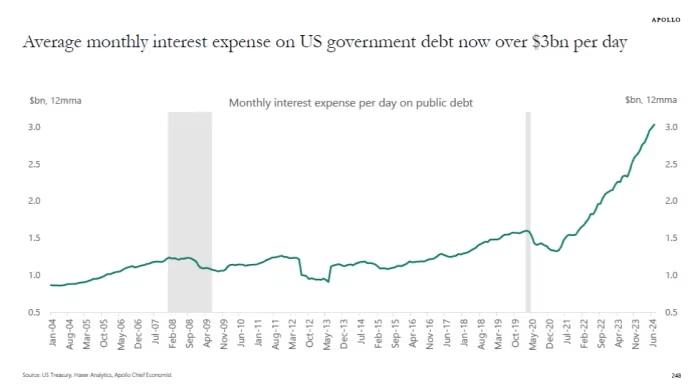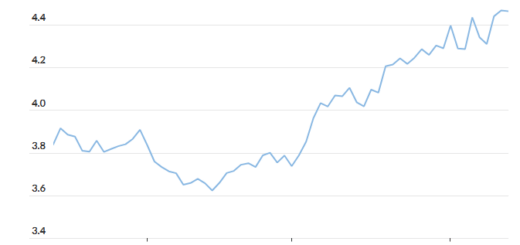Rate Cuts: Softening the U.S. Debt Blow
Over $3 billion is spent daily, even on weekends, to cover the interest payments on the country’s national debt.
Decreases in the Federal Reserve’s interest rates will not only help families and companies struggling to handle higher borrowing costs.
The Treasury would also benefit from reduced borrowing costs as the government continues to spend more than it earns, leading to an increase in the national debt.
Predicted decreases in interest rates might offer some help, but the underlying problem of a substantial government debt load that is expected to grow in the coming years will not be fixed.
The predicted cuts in interest rates by the Federal Reserve are anticipated to happen in September. Some investors are worried that this might suggest an upcoming recession in the economy. But do we really need to be concerned? We will analyze economic markers to see if these decreases are a hint of approaching difficulties.
Furthermore, the ability to repay this debt will rely on the unpredictable choices of global investors who buy and sell U.S. assets. The amount of money owed in the Treasury market is around $28 trillion.
During an interview, Sid Vaidya, the chief investment strategist at TD Wealth, highlighted the significance of keeping a close eye on the amount of debt in the economy.
He stated that if the Federal Reserve adjusts its monetary policy by decreasing interest rates through rate cuts, it may lead to a decrease in the government’s interest payments. Additionally, he mentioned that this transition would help others by leading to a gradual decrease in interest rates within 18-24 months.
Roger Hallam, Vanguard’s global head of rates, mentioned that the relief would be minimal when discussing the government’s debt situation. Lowering interest rates will not have an effect on the United States.
Taxation and spending policies, which play a major role in creating the deficit, are still substantial at 6.7% of the United States’ economy.
The nonpartisan think tank, the Center on Budget and Policy Priorities, has determined the total value of goods and services produced within a country, known as the gross domestic product.
Who wants U.S. debt?
Lately, investors have been less focused on the rising U.S. The debt brought about by the pandemic was as high in October as it was before.
Recently, the 10-year Treasury yield unexpectedly reached 5%, the highest it has been in 16 years. This increase has raised concerns among investors and led to worries about the future of the U.S. economy.
This summer, new U.S. investments were eagerly bought by investors.
Treasury securities without a hitch.
This has helped the U.S. The government’s debt has increased to more than $35 trillion in August, up from approximately $32.8 trillion the previous year. Steve Foresti, a senior investment advisor at Wilshire Advisors, stated that this trend will continue until it suddenly stops.
The borrowing by the government during the global financial crisis in 2007-2008 and the pandemic in 2020 was viewed as advantageous in providing support to both financial markets and the economy.
Foresti said that despite the U.S. successfully avoiding a recession, the continuous deficit spending is causing worries about the potential effectiveness of future policy measures in case of another crisis. Foresti voiced worry about the possible outcomes if this continues to expand without bounds.
In this situation, he has been recommending to clients that they should vary the assets in their stocks and bonds portfolios by including a combination of assets that could help offset the negative impact of inflation over time.
He mentioned that valuable assets such as gold, real estate, and the SP500, as well as inflation-linked securities like TIPS or Treasury securities, could be good examples. He observed that cutting costs has not been a major focus for either of the candidates competing for the presidency in November.
Interest costs $3 billion each day
Torsten Slok, chief economist at Apollo Global Management, reported that the typical monthly interest expenses in the United States.
The government’s daily expenses have risen to more than $3 billion, even on weekends, because of growing debt and increased interest rates. This represents a substantial increase from the amount of approximately $1 billion per day before the pandemic.
Slok told MarketWatch that decreases in interest rates will be advantageous.

He mentioned that the amount of debt is constantly rising and there is no indication that it will decrease in the near future.
Lowering the interest rates set by the federal government will not solve this problem. Recently, the U.S. Treasury has been prioritizing the acquisition of shorter-term debt, specifically T-bills.
Nonetheless, there has been a slight improvement in the auctions of long-term debt, as the yields have decreased to levels similar to those observed earlier in the year.
The 10-year bond yield has dropped to below 4% because people are anticipating reductions in interest rates from the Federal Reserve.
During his address at the yearly Jackson Hole economic conference, Federal Reserve Chair Jerome Powell highlighted the importance of lowering interest rates.
Vaidya from TD Wealth explained that a decrease in yields would be beneficial for the government.
When the music stops
Former President of the Kansas City Federal Reserve, Thomas Hoenig, foresees challenges in managing the funding of the United States debt.
He told MarketWatch that the government is looking to raise $2 trillion in new debt funding for this year. This involves restructuring one-third of their current debt and securing additional debt from an external source. Foreign purchasers are not as excited as they once were.
He mentioned that the only thing left to consider is regarding domestic matters or the actions of the Federal Reserve. “And I am not at ease with that.”
Hoenig, who opposes government involvement and the Fed’s support of financial markets, stated his preference for private discussions that could prompt Congress to tackle its fiscal problems.
Hoenig said that the Federal Reserve needs to be ready to recognize that it cannot entirely cover all of the debt.
He stressed that while monetary policy and financial assistance were crucial during the COVID crisis, not all expenses can be covered.




